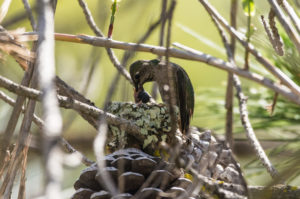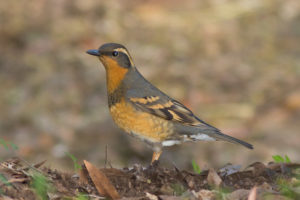
Humans have been observing and wondering about bird movements since forever. The ancient Greek poet Homer described the Trojan army as being like cranes that “flee from the coming winter and sudden rain.” And from the prophet Jeremiah: “Yea the stork in heaven knoweth her appointed times.” Well and good, but how in heaven’s name do the birds knoweth the proper time and how the heck do they findeth their way? Much progress has been made by ornithologists in the last 60-or-so years in beginning to answer those questions. Not unexpectedly, the answers are complex and multifold, the research ongoing.
You probably know that a large portion of North American birds—75 percent of the 650 species that nest here—migrate, or move from breeding grounds to wintering grounds and back. (That’s different from dispersal, when a young bird fledges and leaves the nest for new territory, and irruption, when birds are forced out of their normal feeding areas due to lack of available food.) But did you know that migration is mostly a northern hemisphere phenomenon? Among the reasons for that: There is simply more land available in the northern expanses of the earth. Just look at a globe to confirm this.
We know birds are able to both orient (use an internal compass to determine direction of travel) and navigate (find a specific location using that internal compass). And we know that they, like humans with our maps and GPS and stopping to ask strangers for directions, use multiple systems to find their way.
First, in the 1950s, scientists discovered that birds use a so-called “sun compass” to tell direction, and it works in conjunction with their internal clock. Birds “understand” that at 3 p.m. the sun is in a different place than at 8 a.m. and make adjustments. They are also sensitive to polarized light, which means even on partly overcast days their sun compass works. A well-known study by Stephen Emlen, a behavioral ecology professor at Cornell University, observed captive indigo buntings to prove that migrating birds rely on a “star compass” by night, based on the North Star. And finally, in the 1960s, scientists established the existence of a kind of inner magnetic compass, by altering the magnetic polarity that captive migrating birds were exposed to; the direction of travel changed accordingly.
Now, exciting new research reveals the possible “how” of that latter finding. It seems that birds’ eyes feature specialized cells called cryptochromes, some of which undergo particular chemical reactions, depending on the influence of the earth’s magnetic field—meaning that birds may essentially be able to see magnetism.
Think about that for a second. What is actually happening there on the cellular level is amazingly cool. Then, consider: how in the world did this process evolve? That ability, that chemical process, that particular reactive cryptochrome, seems to have enabled some birds to reproduce more successfully than others, and here we are. That’s just wonderful.
Plenty of other animals are also magnetic navigators: newts, sea turtles, fish, mole rats, deer, dogs. (There’s even some research indicating humans can sense changes in magnetic fields—although I’ve certainly known plenty of people in my time who couldn’t magnetically navigate their way out of a shoebox.) But once a bird has the general travel direction, other factors come into play that fine-tune the route. Some birds use geographic features like large rivers, mountains, or ocean shores to chart their course. There are magnetic anomalies birds may “recognize” as intrinsic earth features. For instance, homing pigeons use landmarks like buildings to help find the way back to their domicile. A few species, like storm petrels, may even use smell to find their home burrows.
When I lived in West Marin years ago, a barn swallow made a nest above our kitchen door for three years running. When the bird family departed in late summer, they presumably flew all the way to Argentina to enjoy the insects in the vernal pampas. And then the same pair returned to our back porch. That’s a very long trip indeed.




